A Winemaker’s Perspective
By Jeremy Eubanks- Winemaker Walla Walla, WA
The first time I smelled TCA in a cellar, I stopped in my tracks. I looked at the winemaker who was walking with me through the barrel room and asked "do you smell that?" He did not, but you could see the alarm in his eyes.
TCA, whose actual name is 2,4,6-Trichloroanisole (and 2,4,6-Tribromoanisole, among others in a family of chemical compounds) is commonly called "cork taint". You sometimes hear people talking about a wine being "corked" when it has an intolerable musty aroma, akin to wet cardboard, an old barn, or a basement that never gets quite dry. The wine is ruined when it comes in contact with this compound. It's undrinkable. The sensory threshold for a person to smell TCA is incredibly low (around 4 parts per trillion). It mutes all of the fruit aromas in the wine, and is the one flaw that you won't find someone defending in a wine. No winemaker ever means for TCA to be present in their wine. It's standard policy at most wineries to take back any corked wine, so affected every bottle is potential lost revenue. With a standard barrique (barrel) holding around 25 cases, one bad barrel could be thousands of dollars in lost revenue (and possibly even more in damage to reputation-as consumers largely still don't understand what causes the flaw).
TCA is called "Cork Taint" because the main culprit to transmit TCA into wine is a cork. In the past, it could come from the cork, from the cork being washed in bleach, from wineries using bleach to clean with, water used in the winery not being de-chlorinated, and a number of other random scenarios. With modern knowledge, that list has been whittled down to two: corks, which are increasingly being tested and guaranteed- and that there are alternatives to, and oak barrels. Much is still unknown about exactly how many barrels may have TCA.
That first time I smelled TCA in a cellar, I walked over with the winemaker to the stack of barrels where the aroma was coming from and I pointed to the barrel with plastic wrap on it. He sniffed, and immediately raised the alarm for his crew to get the barrels out of the cellar. Despite the reportedly small number of barrels coming in to the US affected with TCA (or other similar- smelling anisoles), I've witnessed this two other times at other wineries, once having to take shavings at the cooper's request to send in to ETS Labs to test for the compound. The shavings came back positive. The Cooper blamed the shipping container, whose wood floors can sometimes house the flaw and transfer to barrels. No matter the fault, that could have potentially ruined a lot of wine.
As winemakers trend away from small format into large barrels, the dangers just increase. A lot of foudre, demi-muids, and other oak tanks aren't toasted, and un-toasted oak is very susceptible at picking up TCA unless the cooper has cured it in perfect conditions.
Corked Wines with no corks have been reported at many wine competitions. I've personally judged wines that were under synthetic closure and were "corked." Andrew Jefford once mentioned 10 % of wines at the Decanter wine awards were corked, but under screw-caps or other non-cork closures. Where did the TCA come from? Some of them could've been false positives- with the judge mislabeling the flaw, but it's not a far leap to look to the barrels in the cellar of the offending wines.
Any loss of wine or revenue in a winery is heartbreaking; the countless hours of work turning out to be for nothing. The wine industry continues to innovate and find new ways to make sure this doesn't happen. But TCA sniffing dogs? Absolutely. Anything we can do to get the wine to the customer in perfect conditions sounds worth it to me!
